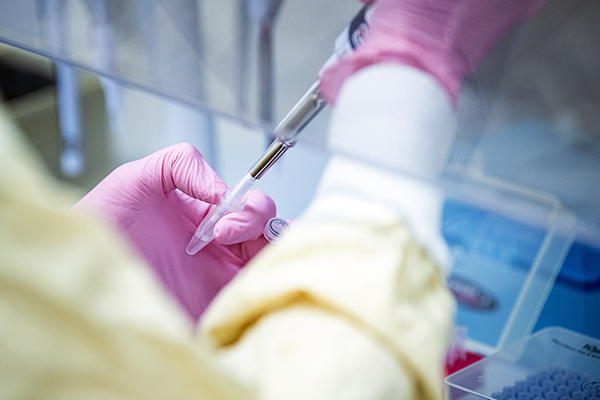Queen’s-KHSC team develop in-house COVID-19 test
May 5, 2020
Share

Testing is key to containment and management of the novel coronavirus pandemic. Yet, the costs, availability, and current timelines for testing have challenged health-care systems worldwide.
Anticipating these complications, in the early days of the pandemic, a team of researchers from Queen’s University and Kingston Health Sciences Centres (KHSC) partnered with Public Health Ontario Laboratories and Hamilton Health Sciences Center to develop an in-house test that could be completed in large volumes by redeployed and retrained technologists and provide results in 24 hours. The test has since been licensed by the Ontario Ministry of Health.
“We wanted to be up and running with a test for SARS-CoV-2 (the virus that causes COVID-19) as soon as possible because we knew other labs were having supply issues with commercial tests,” says Prameet Sheth, Assistant Professor, Department of Pathology and Molecular Medicine, and Director of Microbiology in the Division of Microbiology at KHSC. “We decided to create our own test so that shortages of reagent (a substance or mixture for use in chemical analysis) would not be a major hurdle in our testing capacity. The second consideration was that the cost of a lab-developed test is about a tenth of the commercial platforms.”
Testing for detection
While all tests for coronavirus have the same principle of detection, each targets a different part of the virus. For example, the test the team developed does not actually detect the virus itself, but it identifies genetic information of the virus.
How is this done? Nasal swab samples from tested individuals are analyzed for any presence of the coronavirus’s genetic material, using a technique known as a “polymerase chain reaction.”
The team explains that PCR is a method used in molecular biology that allows for a particular piece of DNA to be targeted and copied many, many times. Eventually, the genetic sequence is amplified so much that it can be detected by specialized laboratory equipment at KHSC. But if the COVID-19 sequence is not present in the sample, nothing would get duplicated, so the test would be negative.
Once samples are ready, it takes three to four hours to complete the process and results are reported out as soon as they are available. This has allowed not only more tests to be completed – from a few per day to a capacity of 400 per day – in the Kingston region, but also for Kingston, Frontenac and Lennox and Addington Public Health to inform tested patients of outcomes within two days.
The result is more tests and faster results at a fraction of the cost. The team’s testing technique has been shared with other laboratories across Ontario through a provincial diagnostic network, which has been set up so that Ontario could see a coordinated approach to COVID-19 testing across the province.
A networked approach
Established by Ontario Health, the network includes all Ontario laboratories undertaking COVID-19 testing to ensure all labs can meet capacity and testing requirements and work together to manage needs. The group meets seven days a week as a means of sharing laboratory data, problem solving, and idea generation.
“Laboratories have never seen the volume of testing that has been pouring in as a result of the pandemic,” says Lewis Tomalty, Assistant Professor, Department of Pathology and Molecular Medicine and Service Chief, Clinical Microbiology at KHSC. “Early on, a number of the large labs that would normally be the primary providers of such testing became overwhelmed and turnaround times started to suffer. The goal of the network is to ensure the ability to offload from labs that were at overcapacity to other labs that had the ability to take on more volume.”
This partnership means that all laboratories are able to provide COVID 19 results in reasonable timeframes, and immediately react and re-direct specimens if a laboratory goes down (e.g. equipment malfunction or supply limitations).
The Queen’s and KHSC team will continue to monitor the virus and will be sure to adapt the test if the virus changes over time, which is something they do each year for influenza.